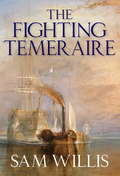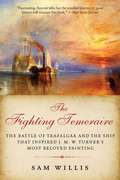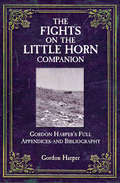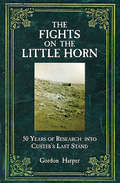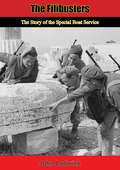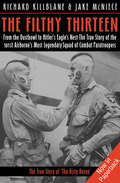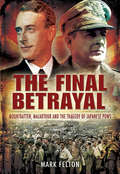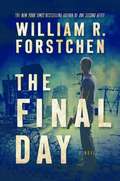- Table View
- List View
The Fighting Temeraire: Legend of Trafalgar (Hearts of Oak Trilogy Vol.1) (Hearts of Oak Trilogy)
by Sam WillisJ.M.W. Turner's The Fighting Temeraire Tugged to her Last Berth to be Broken Up (1838) was his masterpiece. Sam Willis tells the real-life story behind this remarkable painting. The 98-gun Temeraire warship broke through the French and Spanish line directly astern of Nelson's flagship Victory during the Battle of Trafalgar (1805), saving Nelson at a crucial moment in the battle, and, in the words of John Ruskin, fought until her sides ran 'wet with the long runlets of English blood...those pale masts that stayed themselves up against the war-ruin, shaking out their ensigns through the thunder, till sail and ensign dropped.' It is a story that unites the art of war as practised by Nelson with the art of war as depicted by Turner and, as such, it ranges across an extensive period of Britain's cultural and military history in ways that other stories do not. The result is a detailed picture of British maritime power at two of its most significant peaks in the age of sail: the climaxes of both the Seven Years' War (1756-63) and the Napoleonic Wars (1798-1815). It covers every aspect of life in the sailing navy, with particular emphasis on amphibious warfare, disease, victualling, blockade, mutiny and, of course, fleet battle, for it was at Trafalgar that the Temeraire really won her fame. An evocative and magnificent narrative history by a master historian.
The Fighting Temeraire: The Battle of Trafalgar and the Ship that Inspired J. M. W. Turner's Most Beloved Painting
by Sam WillisThe extraordinary story of the mighty Temeraire, the ship behind J. M. W. Turner's iconic painting. The H.M.S. Temeraire, one of Britain's most illustrious fighting ships, is known to millions through J. M. W. Turner's masterpiece, The Fighting Temeraire (1839), which portrays the battle-scarred veteran of Britain's wars with Napoleonic France. In this evocative new volume, Sam Willis tells the extraordinary story of the vessel behind the painting. This tale of two ships spans the heyday of the age of sail: the climaxes of both the Seven Years' War (1756-63) and the Napoleonic Wars (1798-1815). Filled with richly evocative detail, and narrated with the pace and gusto of a master storyteller, The Fighting Temeraire is an enthralling and deeply satisfying work of narrative history.
The Fights on the Little Horn Companion: Gordon Harper's Full Appendices and Bibliography
by Gordon HarperA treasury of sources and supplemental information for readers of the award-winning history The Fights on the Little Horn. This volume collects and lists books, booklets, pamphlets, manuscripts, personal and family papers, newspapers, magazines, periodicals, correspondence, interviews, military and historical journals, military and government reports, and more used by Gordon Harper, author of The Fights on the Little Horn, in his extraordinary years-long research into Custer&’s Last Stand. As a companion volume to that book, or a resource for anyone interested in the history of the American West, it is a valuable and comprehensive guide.
The Fights on the Little Horn: 50 Years of Research into Custer's Last Stand
by Gordon HarperWinner of the John Carroll Award and the G. Joseph Sills Jr. Book Award. A deeply researched work on the infamous 1876 battle, filled with new discoveries. This remarkable book synthesizes a lifetime of in-depth research into one of America&’s most storied disasters, the defeat of Custer&’s 7th Cavalry at the hands of the Sioux and Cheyenne, as well as the complete annihilation of that part of the cavalry led by Custer himself. The author, Gordon Harper, spent countless hours on the battlefield itself, as well as researching every iota of evidence of the fight from both sides, white and Indian. He was thus able to recreate every step of the battle as authoritatively as anyone could, dispelling myths and falsehoods along the way. When he passed away in 2009, he left nearly two million words of original research and writing, and in this book, his work has been condensed for the general public to observe his key findings and the crux of his narrative on the exact course of the battle. One of his first observations is that the fight took place along the Little Horn River—its junction with the Big Horn was several miles away—so the term for the battle, &“Little Big Horn&” has always been a misnomer. He precisely traces the mysterious activities of Benteen&’s battalion on that fateful day, and why it couldn&’t come to Custer&’s reinforcement. He describes Reno&’s desperate fight in unprecedented depth, as well as how that unnerved officer benefited from the unexpected heroism of many of his men. Indian accounts, ever-present throughout this book, come to the fore especially during Custer&’s part of the fight, because no white soldier survived it. However, analysis of the forensic evidence—like tracking cartridges and bullets discovered on the battlefield, plus the locations of bodies—assist in drawing an accurate scenario of how the final scene unfolded. It may indeed be clearer now than it was to the doomed 7th Cavalrymen at the time, who, through the dust and smoke and Indians seeming to rise by hundreds from the ground, only gradually realized the extent of the disaster. Of additional interest is the narrative of the battlefield after the fight, when successive burial teams had to be dispatched for the gruesome task because prior ones invariably did a poor job. Though the author is no longer with us, his daughter Tori Harper, along with historians Gordon Richard and Monte Akers, have done yeoman&’s work in preserving his valuable research for the public. &“Having read and studied several previous books on the Custer Battle, I was hoping that something new would emerge and I was not disappointed . . . certainly a book that one cannot put down.&” —Norman Franks, author of Ton-Up Lancs and Under the Guns of the Red Baron
The Filibusters: The Story of the Special Boat Service
by John LodwickFirst published in 1947, this novel from British author John Lodwick is an accolade to the British Special Boat Service (SBS), a commando force of some 300 men that inflicted great damage on the enemy in the Mediterranean and the Aegean seas during World War II.Founded in July 1940 by Commando officer Roger Courtney, and initially named the Folboat Troop—after the type of folding canoe employed in raiding operations—the Special Boat Service became the special forces unit of the Naval Service of the United Kingdom. Together with the Special Air Service, Special Reconnaissance Regiment and the Special Forces Support Group, they form the United Kingdom Special Forces and come under joint control of the same Director Special Forces.In The Filibusters: The Story of the Special Boat Service, Lodwick reflects his war experiences and exploits as an officer in the Special Boat Service.
The Filthy Thirteen: From the Dustbowl to Hitler's Eagle's Nest—The True Story of the 101st Airborne's Most Legendary Squad of Combat Paratroopers
by Richard Killblane Jake McNieceThe true story of the 101st Airborne Division&’s most notorious squad of combat paratroopers—the inspiration for the classic WWII film, The Dirty Dozen. Since World War II, the American public has learned of the exploits of the 101st Airborne Division, the paratroopers who led the Allied invasions into Nazi-held Europe. But within the ranks of the 101st, one unit attained truly legendary status. Known as the Filthy Thirteen, they were the real-life inspiration for The Dirty Dozen. Primarily products of the Dustbowl and the Depression, the Filthy Thirteen became notorious within the elite Screaming Eagles for their hard drinking and savage fighting skills. From D-Day until the end of the war, the squad&’s heart and soul—and its toughest member—was a half Native American soldier named Jake McNiece. McNiece made four combat jumps, was in the forefront of every fight in northern Europe, yet somehow never made the rank of PFC. The Filthy Thirteen offers a vivid group portrait of hardscrabble guys whom any respectable person would be loath to meet in a dark alley: a brawling bunch whose saving grace was that they inflicted more damage on the Germans than on MPs, the English countryside, and their own officers.
The Final Advance, September to November 1918: September to November 1918 (British Expeditionary Force)
by Andrew RawsonThis is the story the British Expeditionary Forces part in the final days of the Advance to Victory. It starts with the massive offensive against the Hindenburg Line at the end of September 1918. Second Army launched the first of the British attacks in Flanders on the 28th, followed by Fourth Army the next day along the St Quentin Canal.Both First and Third Armies joined in, breaking the Hindenburg Line across the Lys plain and the Artois region, taking Cambrai by 10 October. The narrative then follows the advance through the battles of the River Selle and the River Sambre. It culminates with the final operations, including the actions at Maubeuge and Mons, just before the Armistice on 11 November 1918. Time and again the British and Empire troops used well-rehearsed combined arms tactics to break down German resistance as the four year conflict came to an end.Each stage of the six week long battle is dealt with equally, focusing on the most talked about side of the campaign, the BEFs side. Over fifty new maps chart the day by day progress of the five armies. Together the narrative and the maps explain the British Armys experience during the days of World War One. The men who led the advances, broke down the defences and those who were awarded the Victoria Cross are mentioned. Discover the end of the Advance to Victory and learn how the British Army reached the peak of their learning curve.
The Final Archives of the Führerbunker: Berlin in 1945, the Chancellery and the Last Days of Hitler
by Paul Villatoux Xavier AiolfiCollected documents offering a look into the minds of the Third Reich’s leaders in their final days, and at Berlin following the end of World War II.In November 1945, two French officers secretly entered the Führerbunker, the air raid shelter near the Chancellery in Berlin. The bunker was the last home of Adolf Hitler; the background of the last months of his life and the war; where he married Eva Braun on April 29, 1945; and where he killed himself less than two days later.In the middle of a heap of furniture and broken objects, the two officers found hundreds of documents littering the ground. Among the documents that they retrieved were a dozen telegrams of historic importance that allow us to understand the spirit of the last leaders of the Third Reich as well as the events that took place between April 23 and 26, 1945. These and other documents are presented for the first time in this book, shown in their proper context with an expert commentary.“But although the building may have gone, troves of historic documents survived. Now, many have been published for the first time in this new visual history, an excellent guide to the horrendous final days, hours, and minutes of the Third Reich.” —Military History Matters
The Final Betrayal: MacArthur and the Tragedy of Japanese POWs
by Mark FeltonThis book examines the period between the unconditional surrender of Japan on 14 August 1945, and the arrival of Allied liberation forces in Japanese-occupied territories after 2 September 1945. The delay handed the Japanese a golden opportunity to set their house in order before Allied war crimes investigators arrived. After 14 August groups of Allied POWs were brutally murdered. Vast amounts of documentation concerning crimes were burned ahead of the arrival of Allied forces. POW facilities and medical experimentation installations were either abandoned or destroyed. Perhaps the greatest crimes were continuing deaths of Allied POWs from starvation, disease and ill-treatment after the Japanese surrender. The blame rests with the American authorities, and particularly General MacArthur, Supreme Allied Commander in the Pacific. MacArthur expressly forbade any Allied forces from liberating Japanese occupied territories before he had personally taken the formal Japanese surrender aboard the USS Missouri in Tokyo Bay on 2 September 1945. Vice Admiral Lord Mountbatten, Commanding Allied forces in Southeast Asia, protested against this policy, believing that pandering to MacArthurs vanity and ego would mean condemning many starving and sick prisoners to death. Deaths among British and Commonwealth POWs were significant as opposed to American POWs who were already largely liberated in the Philippines and elsewhere.
The Final Collapse [Illustrated Edition]
by General Cao Van VienGeneral Cao Van Vien describes the final collapse of the South Vietnamese forces in 1975 following the military U.S. withdrawl."General Cao Van Vien was the last chairman of the South Vietnamese Joint General Staff. For almost ten years he worked closely with other senior Vietnamese officers and civilian leaders and dealt with U.S. military and civilian representatives in Saigon. General Vien is therefore particularly well qualified to give an account of the final years from a South Vietnamese standpoint. "This is one of a series of monographs written by officers who held responsible positions in the Cambodian, Laotian, and South Vietnamese armed forces."Includes over 20 maps, tables and illustrations.
The Final Curtain: Veterans' Stories
by Jeremy ArcherThe Final Curtain: Burma 1941-1945 comprises interviews with some of the very few surviving veterans of this most arduous of campaigns. In their own words, soldiers, sailors and airmen now aged between 95 and 101 vividly recount the experiences that they endured more than seventy-five years ago. This is oral history at its best, from officers and men of 14th Army, which comprised some 100,000 British and other Commonwealth personnel, 340,000 from the Sub-Continent and 90,000 East and West Africans. The interviewees include individuals from all these groups. Their accounts cover the retreat from Burma, the Chindit operations behind Japanese lines, the hard-fought struggle in the Arakan, the crucial battles at Kohima and Imphal, and the final advance to Rangoon, culminating in a decisive victory. The veterans featured in this fascinating collection include a Primus (Archbishop) of the Scottish Episcopal Church, a former Chairman of Manchester City Football Club, and the Principal of the Accra Polytechnic in Ghana as well as two career Army officers. Regardless of their post war achievements, all the contributors share the distinction of having served in a hugely demanding and ultimately victorious campaign against a merciless enemy. Their accounts make for inspiring and unforgettable reading.
The Final Day (John Matherson Series #3)
by William R. ForstchenA major release in the New York Times bestselling One Second After series, set in an alternate America rebuilding after an electromagnetic pulse, this is William R. Forstchen's The Final Day. Since the detonation of nuclear weapons above the United States more than two years ago, the small town of Black Mountain, North Carolina has suffered famine, civil war, and countless deaths. Now, after defeating a new, tyrannical federal government, John Matherson and his community intend to restore their world to what it was before the EMP apocalypse. For the most part, they are succeeding. This period of relative stability doesn’t last long. A new, aggressive government announces that it’s taking over and ceding large portions of the country to China and Mexico. The Constitution is no longer in effect, and what’s left of the U. S. Army has been deployed to suppress rebellion in the remaining states. John fears he and his town will be targets. General Bob Scales, John’s old commanding officer and closest friend from prewar days, is sent to bring John into line. Will John and his people accept the new, autocratic regime? Or will revolution rip the fledgling nation apart at the seams? Months before publication, William R. Forstchen’s novel One Second After was cited on the floor of Congress as a book all Americans should read. This third book in the series immerses readers once more in the story of our nation’s struggle to rebuild itself after an electromagnetic pulse wipes out all electricity and plunges the country into darkness, starvation, and death.
The Final Encyclopedia: The Childe Cycle Book 7 (CHILDE CYCLE)
by Gordon R DicksonThe Final Encyclopedia tells of the events which occur when the human race is split into three splinter cultures: the Friendlies, fanatic in their faith; the truth-seeking Exotics; and the warrior Dorsai. But now humanity is threatened by the power-hungry Others, whose triumph would end all human progress. Hal Mayne is an orphan who was raised by three tutors: an Exotic, a Friendly and a Dorsai. He is the only human capable of uniting humanity against the Others. But only if he is willing to accept the terrible destiny of . . . Saviour of mankind.
The Final Fury: Invasion! #4
by Dafydd Ab HughFor ages they have sought to claim our worlds. Now, at last, we take the battle to them. . . . Far from the Federation's desperate war against the invading Furies, the crew of the U.S.S. VoyagerTM encounters something they never expected to hear again: a Starfleet distress call. The signal leads them to a vast assemblage of non-humanoid races engaged in a monumental project of incredible magnitude. Here is the source of the terrible invasion threatening the entire Alpha Quadrant -- and, for the Starship VoyagerTM, a possible route home. But soon there may not be any home to return to . . .
The Final Hour: A Novel (The Barbours and Bouchards Series #3)
by Taylor CaldwellIn the final chapter of the saga that began with Dynasty of Death and The Eagles Gather, a global munitions empire must take sides in World War II. Peter Bouchard journeyed from afar to intervene in the power struggle between Armand and Christopher Bouchard. At stake was control of the family’s vast conglomerate spanning the armament, airplane, and automobile industries. Now Peter and his wife, Celeste, have returned from Europe, where the winds of war are blowing once again. Peter warns that the coming conflict will be one of the darkest chapters in human history—but the Bouchards have always profited in dark times. Henri Bouchard has grown into a ruthless tycoon, but when he sees the threat to America, he throws himself into the war effort with single-minded determination. As he battles bureaucracy and rival powers within his own family, he finds himself drawn to Celeste, the woman he once loved. This, one of Taylor Caldwell’s most subtle romances, awakens Henri’s compassion even as it threatens his grip on the Bouchard dynasty. A “sprawling . . . lush” novel that captures the clamor and uncertainty of the years before the Second World War, The Final Hour is a fitting conclusion to the trilogy that stands as one of Caldwell’s finest achievements (Kirkus Reviews).
The Final Innings: The Cricketers of Summer 1939
by Christopher SandfordJoint winner of the Cricket Society and MCC Book of the Year 2020 awardThe declaration of war against Germany on 3 September 1939 brought an end to the second (and as yet, final) Golden Age of English cricket. Over 200 first-class English players signed up to fight in that first year; 52 never came back. In many ways, the summer of 1939 was the end of innocence. Using unpublished letters, diaries and memoirs, Christopher Sandford recreates that last summer, looking at men like George Macaulay, who took a wicket with his first ball in Test cricket but was struck down while serving with the RAF in 1940; Maurice Turnbull, the England allrounder who fell during the Normandy landings; and Hedley Verity, who still holds cricketing records, but who died in the invasion of Sicily. Few English cricket teams began their first post-war season without holding memorial ceremonies for the men they had lost: The Final Innings pays homage not only to these men, but to the lost innocence, heroism and human endurance of the age.
The Final Invasion: Plattsburgh, the War of 1812's Most Decisive Battle
by David Fitz-EnzA major event in both America's history and the European wars of the nineteenth century, the War of 1812's Battle of Plattsburgh saw the largest invasion ever of a foreign military into the United States, as the British army and navy, fresh from victories against Napoleon, attempted to conquer Lake Champlain and its shores. Their plan was to seize control of key waterways and port cities, a move that would cripple America's defenses. Outnumbered and outgunned, the U. S. land and sea forces fought the British ships and troops to a standstill, allowing the leader of the American fleet, Lieutenant Thomas Macdonough, to carry out a brilliant maneuver which ensured an American victory. Author Fitz-Enz researched and produced a companion PBS documentary that examined the leaders on both sides of the conflict and their actions during the battle. His research brought to light numerous documents, including diaries and secret battle orders, that reveal new insights into the battle. His descriptions of the confrontation in the pages of The Final Invasion bring to vivid life the cannon blasts that tore through ships and their crews and the rush of infantry storming the fortifications around the city. Endorsed by the U. S. Army War College, The Final Invasion is a thrilling look at a pivotal moment in American and world history.
The Final Mission of Extortion 17: Special Ops, Helicopter Support, Seal Team Six, And The Deadliest Day Of The U. S. War In Afghanistan
by Ed DarackOn August 6, 2011, a U.S. Army CH-47D Chinook helicopter approached a landing zone in Afghanistan 40 miles southwest of Kabul. The helicopter, call sign Extortion 17, was on a mission to reinforce American and coalition special operations troops. It would never return. Insurgents fired at the Chinook, severed one of its rear rotor blades, and brought it crashing to the ground. All 38 onboard perished instantly in the single greatest moment of sacrifice for Americans in the war in Afghanistan. Those killed were some of the U.S.'s most highly trained and battle-honed commandos, including 15 men from the Gold Squadron of the Naval Special Warfare Development Group, known popularly as SEAL Team 6, which had raided a Pakistan compound and killed Osama bin Laden just three months earlier. The downing of Extortion 17 spurred a number of conspiracy theories, such as the idea that the shootdown was revenge for bin Laden's death. In The Final Mission of Extortion 17, Ed Darack debunks this theory and others and uncovers the truth behind this mysterious tragedy. His account of the brave pilots, crew, and passengers of Extortion 17 and the events of that fateful day is interwoven into a rich, complex narrative that also discusses modern joint combat operations, the history of the Afghan war to that date, U.S. helicopter use in Afghanistan, and the new and evolving military technologies and tactics being developed to mitigate such tragedies now and in the future.Amazon Best History Book of the Month - September 2017
The Final Mission: Spooky 8
by Bob KingThe Final Mission tells the story of Bob King, who for seventeen years, beginning with his military career as a member of the Special Forces Unit in Vietnam, led an incredible double life, carrying out the U.S. government's high-risk missions--without involving its military. Then, in 1992, King and his men, secret members of a U.S. Tactical Reconnaissance Team, were sent to Colombia. The mission was "an easy breather," until the men walked into an ambush and found out the real reason they were there. They had been sent to die.With three men dead, and King himself wounded, the band of mercenaries began a desperate battle for survival-- and for the truth-- that led from South America all the way to Washington, D.C. Now, in this chilling, action-packed book, Bob King goes public: with the covert operations he carried out, the hidden deals he witnessed, and the horrific shadow war he survived-- against a U.S. government desperate to bury its secrets and its own men.
The Final Nexus: The Final Nexus (Star Trek: The Original Series #43)
by Gene DeWeeseUncounted centuries ago, an unknown race from beyond our galaxy created a series of interstellar gates -- shortcuts across our universe -- and then disappeared, leaving behind no clues to their fate, or the operation of their system. Twice before, the Enterprise has used the system to traverse the galaxy, and returned each time no wiser to the gates' operation. Now it is imperative that they find out. For the gates are breaking down, taking the very stars in the sky with them. The fate of the galaxy rests in the hands of the Enterprise crew, and their ability to communicate not only with creatures from another world -- but from another universe as well.
The Final Over: The Cricketers of Summer 1914
by Christopher SandfordAugust 1914 brought an end to the ‘Golden Age’ of English cricket. At least 210 professional cricketers (out of a total of 278 registered) signed up to fight, of whom thirty-four were killed. However, that period and those men were far more than merely statistics: here we follow in intimate detail not only the cricketers of that fateful last summer before the war, but also the simple pleasures and daily struggles of their family lives and the whole fabric of English social life as it existed on the eve of that cataclysm: the First World War. With unprecedented access to personal and war diaries, and other papers, Sandford expertly recounts the stories of such greats as Hon. Lionel Tennyson, as he moves virtually overnight from the round of Chelsea and Mayfair parties into the front line at the Marne; the violin-playing bowler Colin Blythe, who asked to be moved up to a front-line unit at Passchendaele, following the death in action of his brother, with tragic consequences; and the widely popular Hampshire amateur player Robert Jesson, whose sometimes comic, frequently horrific and always enthralling experiences of the ill-fated Gallipoli campaign are vividly brought to life. The Final Over is undoubtedly a gripping, moving and fully human account of this most poignant summer of the twentieth century, both on and off the field of play.
The Final Reflection: A Novel (Star Trek: The Original Series #16)
by John M. FordKlingon Captain Krenn is a ruthless war strategist. But on a mission to Earth, Krenn learns a lesson in peace. Suddenly he must fight a secret battle of his own. His empire has a covert plan to shatter the Federation. Only Krenn can prevent a war -- at the risk of his own life!
The Final Season: The Footballers Who Fought and Died in the Great War
by Nigel McCreryA moving narrative history of the professional footballers who fought and died in World War I, with a foreword by Gary Lineker.In 1914, as today, successful footballers were heroes and role models. They were the sporting superstars of their time; symbols of youth, health and vigour. Naturally enough, when war broke out they felt it was their duty to join up and fight. Between 1914 and 1918, 213 professional players fell in action. Some teams lost half their players, either killed or else so badly injured in mind and body that they were never to play again. The Final Season is the powerfully moving account of these young men who swapped the turf of the pitch and the cheers of the fans for the freezing mud of the battlefield and the terrible scream of shell fire. It follows them as they leave their fans and families behind, undergo training and then travel on to the bloody arenas of war: Ypres, Gallipoli, the Somme, Passchendaele. Nigel McCrery paints these men in vivid detail. From their achievements on the football pitch to their heroic conduct on the battlefield, we will learn of the selfless courage and determination they displayed in the face of adversity. For far too many, we will also learn when, and how, they made the ultimate sacrifice.
The Final Secret: The Final Secret / Colton First Responder (the Coltons Of Mustang Valley) (Mills And Boon Heroes Ser.)
by Cassie MilesA security agent must confront her own dark past to stop a deadly plot in the USA Today–bestselling author's romantic suspense novel.As her first assignment with ARC Security, army vet Gennie Fox is tasked with guarding a swanky fundraiser. It seems straightforward enough—until her traitorous ex-fiancé shows up. Suddenly a guest is murdered, and her boss—former SEAL Noah Sheridan—gets caught in the cross fire. Noah trusts the coolheaded beauty to get to the truth. But when Gennie’s past leaves her compromised, can their growing feelings survive the sinister forces at work?
The Final Service
by Gary W. MooreA father and daughter, a secret past, and a search for redemption drive this haunting novel that “celebrates the complexities of love” (Joyce Faulkner). Sandy Richards is a music teacher, wife, and mother living a comfortable life in a small Midwestern town. But her warm smile and easy laugh hide a heavy burden. During her childhood, she was inseparable from her larger-than-life father, a World War II hero she adored. Sandy followed him everywhere, hung on his every word, and loved him with all her heart. Until, for reasons Sandy never understood, their relationship shattered—left broken to the day he died. With grief, regret, and anger, Sandy sorts through her father’s belongings to learn what went wrong, and to deal with all the unresolved pain of the past. Then, as if by providence, a stranger enters Sandy life. And everything changes once more. Exploring the forces in nature that are more powerful than ourselves, The Final Service is “a compelling and endearing” novel about the need for forgiveness and to forgive, and to embrace what matters most in life while it’s still within reach (James Riordan, New York Times–bestselling author).
